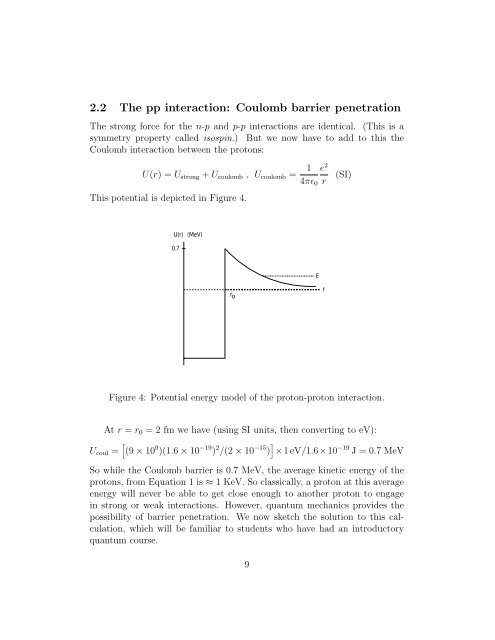Lecture Notes for Astronomy 321, W 2004 1 Stellar Energy ...
Lecture Notes for Astronomy 321, W 2004 1 Stellar Energy ...
Lecture Notes for Astronomy 321, W 2004 1 Stellar Energy ...
You also want an ePaper? Increase the reach of your titles
YUMPU automatically turns print PDFs into web optimized ePapers that Google loves.
2.2 The pp interaction: Coulomb barrier penetration<br />
The strong <strong>for</strong>ce <strong>for</strong> the n-p and p-p interactions are identical. (This is a<br />
symmetry property called isospin.) But we now have to add to this the<br />
Coulomb interaction between the protons:<br />
U(r) = U strong + U coulomb , U coulomb = 1 e 2<br />
4πɛ 0 r<br />
This potential is depicted in Figure 4.<br />
(SI)<br />
U(r)<br />
(MeV)<br />
0.7<br />
E<br />
r o<br />
r<br />
Figure 4: Potential energy model of the proton-proton interaction.<br />
At r = r 0 = 2 fm we have (using SI units, then converting to eV):<br />
U coul = [ (9 × 10 9 )(1.6 × 10 −19 ) 2 /(2 × 10 −15 ) ] ×1 eV/1.6×10 −19 J = 0.7 MeV<br />
So while the Coulomb barrier is 0.7 MeV, the average kinetic energy of the<br />
protons, from Equation 1 is ≈ 1 KeV. So classically, a proton at this average<br />
energy will never be able to get close enough to another proton to engage<br />
in strong or weak interactions. However, quantum mechanics provides the<br />
possibility of barrier penetration. We now sketch the solution to this calculation,<br />
which will be familiar to students who have had an introductory<br />
quantum course.<br />
9













